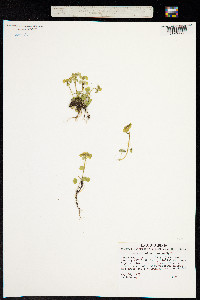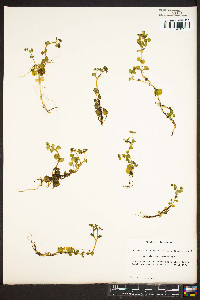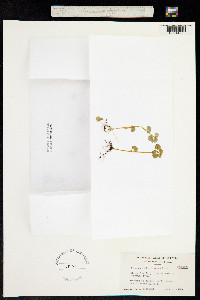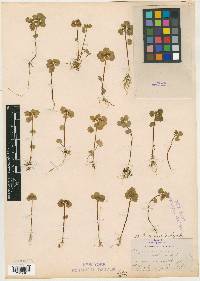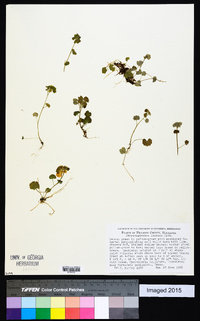Chrysosplenium iowense
|
|
|
|
Family: Saxifragaceae
Alternate-Leaf Golden-Saxifrage
|
Stolons white, 0.3-1.2 mm diam., sparsely villous, hairs white or reddish brown. Flowering stems erect, branching in distal 1/6-1/3, 3-15 cm, glabrous. Leaves alternate, membranous. Stolon leaves: petiole 7-43 mm, sparsely villous, hairs white or reddish brown; blade depressed-ovate to reniform, 6-13 × 7-18 mm, base cordate, margins 5-9-crenate, not purple-spotted, glabrous or sparsely ciliate, hairs white, surfaces glabrous or sparsely villous, especially near petiole, hairs usually white, sometimes purplish. Cauline leaves 1-3; petiole 3-23(-26) mm, glabrous or villous proximally, hairs purplish; blade depressed-ovate to reniform or flabellate, 6-17 × 9-23 mm, base cordate or, rarely, cuneate, margins 5-9-crenate, glabrous, surfaces glabrous abaxially and adaxially or, rarely, villous near petiole, hairs purplish. Inflorescences terminal, 3-12-flowered, compact cymes; bracts greenish yellow, not purple-spotted, foliaceous, ovate to depressed-ovate or flabellate, 2-10 × 2-11 mm, margins 3-7-crenate. Pedicels absent or 0.1-1.2 mm. Flowers: hypanthium yellow or greenish yellow, not purple-spotted, campanulate, 1.2-2.3 × 1.5-3 mm, glabrous; sepals spreading, yellow or greenish yellow, not purple-spotted, ovate to broadly ovate, 0.9-1.5 × 1.1-2 mm, apex obtuse to rounded; nectary disc inconspicuous, yellow, unlobed; stamens 2-8, 0.6-0.7 mm; anthers yellow, 0.1-0.2 × 0.1-0.2 mm; styles 0.3-0.4 mm. Seeds (8-)20-30(-56), reddish brown, ovoid to ellipsoid, (0.5-)0.6-0.9 mm, glabrous. 2n = ca. 120. Flowering May-Jun. Marshes, bogs, wet meadows, stream banks, moist seeps, algific talus slopes, 500-1500 m; Alta., B.C., Man., N.W.T., Sask.; Iowa, Minn. Iowa populations of Chrysosplenium iowense are widely disjunct from Canadian populations. The former are thought to represent Pleistocene relicts, isolated in the Driftless Area of northeastern Iowa and southeastern Minnesota. R. M. Weber (1979) studied the reproductive biology and ecology of the species in northeastern Iowa. H. Hara (1957) treated Chrysosplenium iowense as synonymous with C. alternifolium Linnaeus var. sibiricum H. Hara. J. G. Packer (1963) recognized the close similarity between C. iowense and C. alternifolium var. sibiricum but maintained the two as distinct species in the absence of a modern, detailed analysis of the C. alternifolium complex. That approach is adopted here.
Stem arising from the end of last year's rhizome; lvs all alternate, reniform, conspicuously crenate-toothed, the lower long-petioled; fls 3-5 together in small, nearly sessile, terminal cymules; sep bright yellow; stamens 5-8; 2n=96, ±120. Wet, mossy slopes in ne. Io., and widely distributed in the Arctic. May-July. Gleason, Henry A. & Cronquist, Arthur J. 1991. Manual of vascular plants of northeastern United States and adjacent Canada. lxxv + 910 pp. ©The New York Botanical Garden. All rights reserved. Used by permission. |



